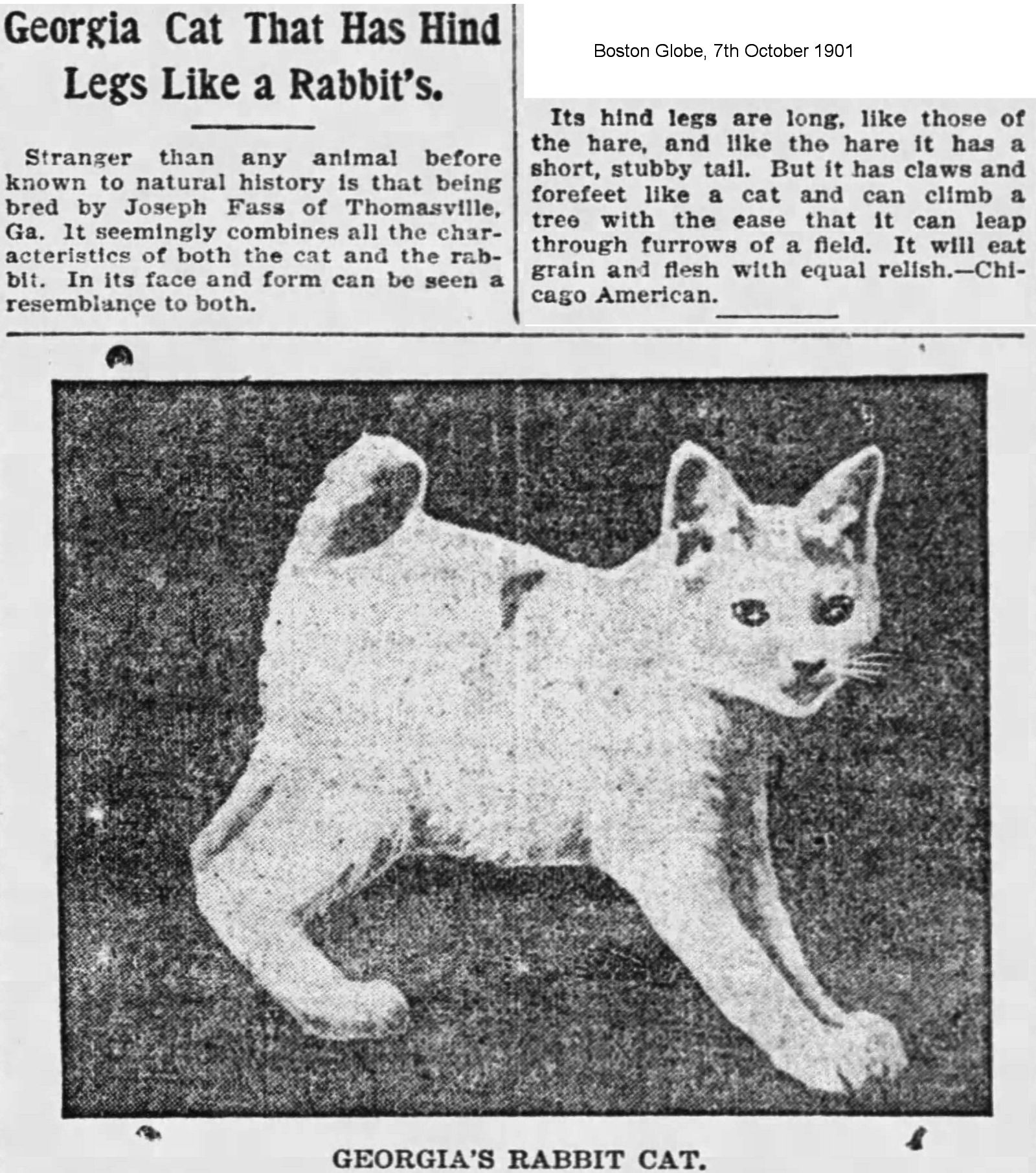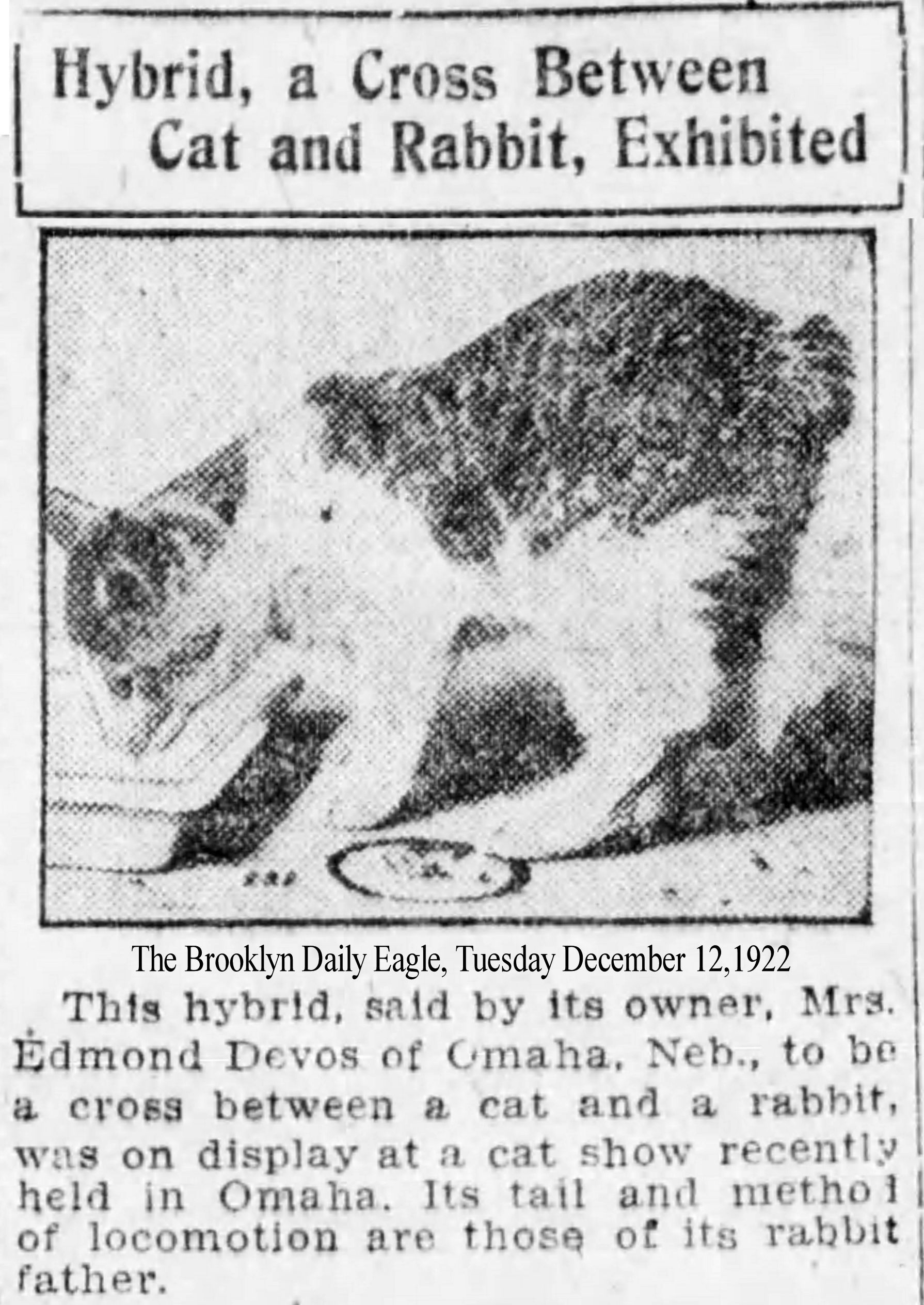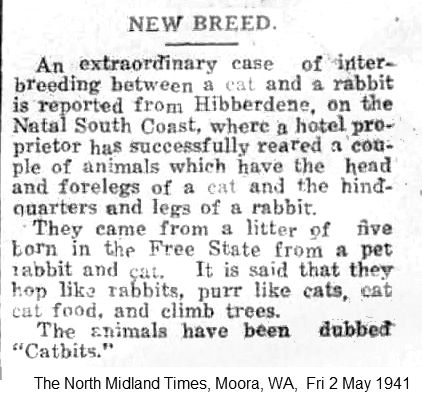
CABBITS - A BRIEF HISTORY
I've had a lot of enquiries from people asking where they can buy a cabbit. They have read two of my articles and misunderstood the information about cabbits. Those who have mailed me thought I was saying that there really are creatures which are part cat and part rabbit. Some even thought I was breeding cabbits or that I knew cabbit-breeders who would sell them a cabbit. Here's what I actually wrote:-
In my list of breeds I wrote: "Genetic problems and Abnormalities: [...] "Winged" cats with flaps of fur hanging from the shoulders have been reported on several occasions. "Cabbits" with rabbit-like hind legs appear to be malformed Manx-type cats. Kangaroo Cats with very short front legs have occurred, possibly an expression of the Munchkin gene. [...] Other deformities include extra legs, extra tails, dwarfism. In general, the associated health problems make these traits undesirable."
In "The Ethics of Breeding for Deformity" I wrote: "Nature sometimes makes genetic mistakes. [...] 'Cabbits' are genetic quirks (often, but not exclusively, found in the Manx breed) where the hind end resembles that of a rabbit rather than a cat. One sometimes reads queries in magazines asking 'What are Cabbits? Where can I find a breeder?'. Someone somewhere may currently be considering the breeding of Cabbits to meet the novelty-value market."
Both times, I wrote that creatures which some people call cabbits are genetic quirks or deformities. I described the hind legs which are rabbit-like or wrote that the hind end resembles that of a rabbit. I certainly haven't written that these creatures are cross-breds. They aren't. They are cats with either a genetic defect or a birth defect. In "The Ethics of Breeding for Deformity" I express concern that someone might try to make money out of this type deformity, I don't say that I know of anyone who is doing this right now nor do I say I'd approve of it.
SUMMARY OF CABBIT MYTH DEVELOPMENT AND ASSOCIATED CLAIMS
1845: "An Historical and Statistical Account of the Isle of Man". The superficial similarity between Manx cats and rabbit inspires writer Joseph Train of Castle Douglas, Galloway to claim Manx cats were the product of matings between female cats and buck rabbits.
1900: The San Juan Islander, December 6th, 1900: Half Cat, Half Rabbit. The Payette, Idaho, Independent tells of family there that claims to have a bunch of kittens that are half rabbits. The story does not say whether there are some cats and some rabbits, but infers that the case is one of cross blood.
1901The Manning Times, February 27th, 1901: A Queer Animal. A dispatch from Tamaqua, Pa., says: Richard Miller of Hauto has a curiosity in the shape of an animal that is half cat and half rabbit. The front portion of the creature, with the exception of its red eyes, is that of a cat, while the rear half is that of a rabbit. One half of the animal s body is covered with the white hair of a cat, while the remainder of its body is covered with the reddish brown fur of a rabbit, ending in a short, bushy tail. It moves about with half run and half hop, and is very tame. It lives on vegetables and milk, and has no use for meat. It is about one-half the size of a full-grown cat.
1901The Lexington Dispatch, July 3rd, 1901: Mr. N.H. Williams, says he has a curiosity at his house in the shape of [an] animal which is half rabbit and half cat. The fore part is like a cat and the hind part looks like a rabbit. It is about six weeks old, and he supposes it to be the result of tame rabbits and cats breeding together.
1901Boston Globe, 7th October, 1901: "Georgia Cat That has Hind Legs Like a Rabbit's."

1903The Minneapolis Journal, January 27th, 1903: (Minneapolis Poultry and Cat Show) The general exhibit includes poultry, homing pigeons, pet stock and cats. Two rare exhibits are a pair of silkies (hens) and a hybrid which is half cat and half rabbit. On Sunday a $25 Angora cat [will be given away]. Each person who buys a ticke will place his name and address on a card in churn and the first name drawn will get the prize.
1903: "The Book of the Cat". Frances Simpson concluded Joseph Train's story was a myth.
1917: A supposed cat-rabbit cross with a stumpy tail was spotted in Texas.

1934: Culver Citizen runs article by Samuel E. Perkins III (formerly president of Indiana Audubon Society) describing 3 strange kittens at Morgan County farmhouse. These resemble Manx, but locals claim there are no Manx in the area, preferring the cat-rabbit myth. Dr HE Anthony, curator of Mammals at the American Museum of Natural History, tells Perkins that Manx and other bobtails are often erroneously called rabbit-cat.
1936: Rabbit-Cat called "Swamp Angel" featured in an American cat care book of 1936. Owner Charles Perry Weimer encourages the (lucrative) image of a cat-rabbit hybrid, but other writers identify Swamp Angel as a nice bobtailed cat.
1930s: A woman (unidentified) writes "No scientist could convince me that there is no such animal. She claims to have seen cabbits 22 years earlier at Winthrop Rifle Range on the Potomac River.

1947: Grace Cox-Ife wrote in "Questions Answered About Cats": There are several points about a Manx ... there is the gait - a rabbity hop rather than a walk- which is caused by the height of the hindquarters: according to the Manx Cat Club these "cannot be too high, and the back cannot be too short, while there must be great depth of flank .... This reinforces the idea of the Manx being rabbit-like.
1950s: Ermelo, Transvaal, South Africa, zoologist Dr Maurice Burton describes a rabbit-like cat. He learned from Prof J W Groenwald that it is a Siamese-Manx cross bred by H E le Tendresse of Arcadia, Pretoria and sold to Mr D Patterson in Ermelo. Dr Burton is evidently unfamiliar with Manx cats.
1951: The Jet City Maven runs a hoax article (only admitted 49 years later). Stan Stapp of the North Central Outlook reads an item in the Seattle P-I commenting on a letter printed in the Canadian "Victoria Times" claiming a female Siamese cat and male rabbit have produced "catabbit" offspring. It later turns out that the catabbit breeder is a professional writer well known for her "lively imagination" and in need of publicity for a children's book about her cat. The Outlook's junior reporter, Li'l Oscar, provides a news story and a photo of a catabbit with a white body, rabbit ears and long striped cat tail. 49 years later, Stan Stapp owns up to perpetrating the hoax; the photo was a composite of his own cat and rabbit made using glue and scissors.
1955: Rose Tenent wrote in "Pedigree Cats": No cat is more fascinating than the tailless Manx, with its rabbit-like hoppity gait [...] . The hind legs are considerably longer than the front ones, thus giving the cat its peculiar hopping gait; incidentally, also the reason for the ridiculous theory held in some quarters that the Manx cat is the result of a cross-mating between a cat and a rabbit.
1950s: PM Soderbergh wrote in "Your Cat" (1951) & "Pedigree Cats, Their Varieties, Breeding and Exhibition" (1958): The normal gait of the Manx is different from that of the ordinary cat, and in some respects is similar to that of the rabbit, but there is no truth in the statement sometimes made that this breed was originally the result of a cross between a rabbit and a cat. That is sheer nonsense. and the hind legs are longer than those in front. From this difference in length of leg the peculiar gait of the breed arises, and it is as a result of this that the Manx has been called the 'Rabbit cat'. On a number of occasions it has been stated with apparent seriousness that this variety was, in fact, first produced by crossing a rabbit with a cat, but any such statements can be regarded as sheer nonsense.

1960s: Bobtailed cat found in Arizona gives rise to American Bobtail breed. Later spate of cabbit sightings in neighbouring New Mexico (and previously in Texas) suggests genes for bobtailed trait have become established in that region.
1970s: Harry Goodwin, of Lower Swatara Township, Pennsylvania decides his Manx cat is a cabbit. His vet, unfamiliar with Manxes, compounds the error.
1974: (Unconfirmed) Detroit Free Press publishes article and pictures of a "cabbit", possible an an April Fool's Day prank.
1977: Val Chapman finds a pink-eyed white "cabbit" on a reservation in New Mexico and exhibits it in a Farmington shopping mall and in Los Angeles. Chapman claims it is a hybrid and it appears on the Johnny Carson show between July and october 1977 and again in 1978. Los Angeles zoologists say this is impossible and identify it as a cat. It has a deformed pelvis that forces its legs out and back. With few viewers conversant in genetics, the myth of the cabbit takes root.

1977: 2 months after Chapman's claim, Marian Pitcher, of Greenfield, Indiana claims to have a cabbit. Zoo officials refute this, though Dr David Osgood, Professor of Vertebrate Anatomy at Butler University, Indianapolis, doesn't rule it out. Since then it has been proven genetically impossible and Dr Osgood was mistaken in his beliefs.
1977: Cabbit satire on the spoof talk show "Fernwood Tonight" aka "Fernwood 2Nite" (set in Fernwood, Ohio) which aired during the summer of 1977 and which satirized Merv Griffin, Johnny Carson, and other big names of American 1970's Talk TV. The 1977 Fernwood Tonight cabbit sequence went: "That is not his cabbit - it's my cabunny!"
1970s & 1980s: Correspondents mention Val Chapman's cat-rabbit hybrid on the USA TV show "That's Incredible" in the 1970s and twice on Johnny Carson's "The Tonight Show" first in either 1978 or '79 and again in either 1981 or '82.
1993: Josh Berta, a college freshman in Chicago, claims he saw a story on the WGN evening news about a crossbred cat-rabbit. WGN is a reputable news organization and also produces the Chicago Tribune. The story claimed cabbits were to be marketed as pets. Since the story aired, Berta saw and heard nothing more regarding cabbits; other people did not recall the story and he began to think he had dreamt the news segment. If it existed, it was a hoax.
1993:Lisa Hackett also remembers the WGN news segment in 1993 about cabbits. Lisa was in third grade in 1993, and lived in Wheeling, WV; her father often watched WGN news, she could have seen the same segment that Josh Berta remembered. She remembers watching it with her mother and being completely enthralled with the animal (apart from the name cabbit !), which looked like a cat but hopped like a bunny and had a cotton tail. A woman was talking about how rare they were, and showed it hopping around. The purported cabbit was white with a secondary darker colour. The news segment showed it hopping near the left/centre of the screen outside on the grass, and Lisa recalls thinking, "Oh no, what if it runs/hops away? Why would they risk letting it be outside?"
1996: Trevin Edgeworth allegedly sees cat-rabbit hybrids (gatonejos - gato = cat, conejos = rabbits) in Morovis, Puerto Rico, supposedly being bred by a local woman from a cat and a rabbit and used for meat patties.
2001: Summer 2001, a US talk show (claimed to be Maury Povich) features a cabbit story.
2002: Michael Mastro writes that a client has obtained 2 cabbits from a breeder in California. One was tabby, the other was black and both weighed almost 30 pounds. Michael's vet claims cats and rabbits will mate (they will mount each other, but can't produce offspring). From size and description, these may have been Continental Giant rabbits, one brindle, one black.
2003: Correspondent in Cyril, Oklahoma claims to have seen cabbits in Elgin, Oklahoma. The animals' owner claimed they had come from Washington state. The descriptions match Manxes.
2005: Manuel Ortiz from New York recalls seeing alleged cabbits from the Dominican Republic on the Primer Impacto show on the Spanish network Univision at the end of the 1990s or beginning of the 2000s.
2005: (January) All Wildlife Rescue and Education Inc (AWRE) prints photo-manipulated cat images with the story that it is a cat-rabbit called Cabot, accidentally created during in vitro fertilization experiments and needing a good home. The story does not appear in any peer-reviewed scientific journals and can be discounted as a hoax.
2007/8: White "cabbit" shown on a Discovery channel pet programme is revealed to be a young white Manx nicknamed a cabbit by his young owners.
2007/8: Georgia woman advertises cabbits for sale at $1000 each; the cabbits turn out to be bobtailed cats.
|
IMPORTANT NOTE I often receive emails from people saying "I have personally seen a cabbit" or "I have a cabbit" or "cabbits are born but don't survive" or even "My vet says it is a cabbit". What you have is a cat with one or more of those traits which make it resemble a rabbit and a vet with a sense of humour or who watches too many cheap talk shows. Absolutely the ONLY proof of a cabbit existing in real life is independently verified DNA evidence to prove that the animal you have is a hybrid. If the DNA evidence was real, it would be big news (as big as cloning) and would be printed in scientific journals, nature journals and veterinary journals. This site will not consider any claims of genuine cabbits unless supported by material from reputable, respected scientific journals Ask yourself these questions: Do you really, honestly believe that any vet would pass up such an opportunity to become famous, and possibly wealthy, from finding a real-life cabbit? Are you so sure of your claim that you are prepared to have a DNA analysis done on your cat or kittens? Do you have independent scientific evidence from at least 2 accredited laboratories and qualified professional genetics researchers (not hobbyists) to support your claim? Have the results been published in a recognised scientific journal? If not, all you have is a delusion. |
Regardless of the genetic impossibility, it seems that people want to believe in cabbits (especially with the cabbit characters in popular Japanese anime) just like they want to believe in the Easter Bunny - and they will continue to believe in mythical creatures despite all evidence to the contrary.